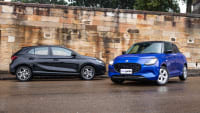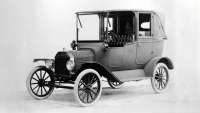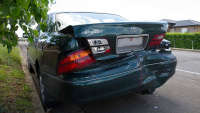You never love to see them in your rear-view mirror, but you do like knowing they’re out on the roads keeping us safe. I’m talking, of course, about police cars.
Over the decades Australian police cars have evolved and changed, from the earliest days of the horseless carriage, through the homegrown Holden and Ford days to today’s diverse fleet.
What is the history of police cars in Australia?
Police forces in Australia began using motorised vehicles as early as the 1910s, with the New South Wales force getting its first car in 1912 and adding a motorcycle in 1913 and a patrol van in 1915. Victorian police added its first patrol cars around the time of the First World War, while other states trailed behind.
Have police cars always been the same make?
No, Australian cop cars have been many different makes over the years. The first car on the New South Wales force was a Sunbeam Roadster, while in Queensland its first motorised police vehicle was a modified horse-drawn carriage that was used as a prison van.
Over the years dozens of different makes and models were used, but by the middle of last century the Australian car industry was at its peak and police forces around the country began driving locally-built Holdens and Fords.
The Holden Commodore and Ford Falcon soon became the default choice for police forces, for marked and unmarked police cars around Australia, until the local industry shut down and the Commodore and Falcon were no longer an option.
How have Australian police cars changed over the years?
In the early days of motorised police forces they were typically standard vehicles, it wasn’t until post World War One that they began to use police radios and standardised the fleets.
After World War Two the police were able to use surplus military vehicles to enhance their rural vehicles to better suit the conditions.
It wasn’t until the 1950s that most police forces began using consistent marking, lights and sirens to make them more recognisable. By the 1970s police began to use V8-powered Fords and Holdens as high-speed pursuit vehicles.
In more recent times, the last 20 years, police cars have had a major upgrade in terms of technology. A modern police car has a lot more than a two-way radio and has a number of cameras that can scan licence plates while on the move and alert officers to any outstanding breaches connected to the vehicle.
.jpg)
What cars are used in each state in Australia?
Since the demise of the local industry and the disappearance of the Holden Commodore and Ford Falcon police fleets around Australia have become incredibly diverse. Here is a list of common vehicles used in each state, as you’ll see there is a difference between what are called ‘general duties’ vehicles and what models are used as Australian highway patrol cars - the most common of the former are the likes of the Hyundai Sonata and Volkswagen Tiguan, while the BMW 530d has become a regular sight on the highways.
However, it should be noted that many other models are used for various purposes, often community engagement. These have included attention-grabbing models like Porsches or conversation starters, like the Hyundai Ioniq 5 the NSW police used recently.
NSW
Volkswagen Passat and Hyundai Sonata (general duties); BMW 530d and BMW X5 (Highway Patrol); Toyota LandCruiser 300 Series (regional); Isuzu D-Max (divisional vans).
.jpg)
Victoria
Volkswagen Tiguan, Hyundai Palisade and Toyota HiLux (general operations), BMW 530d and BMW X5 (Highway Patrol); Ford Ranger (divisional vans).
.jpg)
Queensland
Toyota Camry Hybrid (general duties); Kia Stinger and Kia EV6 (Highway Patrol); Toyota LandCruiser 300 Series (frontline priority incidents).
_0.jpg)
South Australia
Kia Sorento, Toyota RAV4, Volkswagen Tiguan and Subaru Outback (general duties); Toyota LandCruiser 300 Series, Ford Ranger and Toyota LandCruiser 70 Series (regional).
.jpg)
Western Australia
Volkswagen Tiguan and Kia Sorento (general duties); Skoda Superb and Kia Stinger (highway patrol).
.jpg)
Tasmania
Subaru Liberty and Toyota LandCruiser (general duties); Kia Stinger and BMW M340i (Highway Patrol)
.jpg)
Northern Territory
Subaru WRX (Highway Patrol); Toyota LandCruiser 70 Series (regional); Toyota HiLux (divisional van).
![Subaru WRX police car]() Subaru WRX police car
Subaru WRX police car
.jpg)
A.C.T.
Subaru Liberty and BMW X3 M40i (general duties).
How do Australian police cars differ from police cars in other countries?
As you can see from the list above, without the Commodores and Falcons of years gone by, Australian police cars have a more international flavour to them. The Australian fleet is largely made up of German, Japanese and South Korean models these days so naturally there’s some crossover to other areas of the world.
For example, BMW’s rear- and all-wheel drive models like the 3-Series and 5-Series used in Australia are also found in the United Kingdom and German forces. As you’d expect, Germany also uses Mercedes-Benz models and has famously had some Porsche 911 models over the years for publicity - and to act as a deterrent for speeding, even on the autobahns.
.jpg)
In the UK they have drawn from a variety of brands over the years, depending on the specific needs. The Swedish Volvo XC90 has been used regularly for its all-wheel drive capability, while France’s Peugeot has also worked with UK Police for decades.
Perhaps the most famous police cars are the supercars used by the Dubai Police Force. Over the years they have had a Bugatti Veyron, Aston Martin One-77, Bentley Continental GT, Ferrari FF, Lamborghini Aventador and even a Rolls-Royce Wraith.
.jpg)
Contrary to perception, these aren’t the ‘regular’ patrol cars but are used primarily for publicity and tourism purposes. Instead, the majority of the working Dubai police fleet consists of Dodge Chargers, Nissan Pathfinders and Toyota LandCruisers.
Of course we can’t talk about police cars without mentioning the USA, which is famous for its law enforcement vehicles from years of movies and television shows. The Ford Crown Victoria was the popular choice for years, so much so that many police departments stocked up on the reliable sedan when it was discontinued by Ford.
.jpg)
The surprising candidate to replace the ‘Crown Vic’ was none other than the Holden Commodore, in its long-wheelbase form. The Chevrolet Caprice PPV took the Australian luxury car and turned it into a stripped out and strengthened police cruiser with plenty of space in the back for those who didn’t follow the law.
Just like Australia, with the gradual reduction in suitable sedan models, many US police forces have turned to SUVs, such as the Ford Explorer, Chevrolet Tahoe and Dodge Durango. However, the Dodge Charger remains a popular choice for Highway Patrol, and the Ford Mustang has been adopted by some departments.




.jpg)
.jpg)

.jpg)






.jpg)

.jpg)
.jpg)
.jpg)
.jpg)
.jpg)




.jpg)
.jpg)

.jpg)


